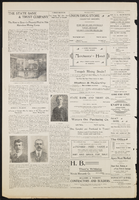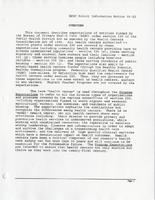Search the Special Collections and Archives Portal
Search Results

Correspondence, Levi Syphus to Dr. W.E. Neel
Date
1927-07-11
Archival Collection
Description
This folder is from the "Correspondence" file of the Sadie and Hampton George Papers (MS-00434)
Text
Felicia Ortiz (Nevada Department of Education) oral history interview conducted by Magdalena Martinez and Kelliann Beavers: transcript
Date
2022-01-13
Archival Collection
Description
From the Lincy Institute "Perspectives from the COVID-19 Pandemic" Oral History Project (MS-01178) -- Elected official interviews file.
Text

Transcript of interview with Frank Cope by Marianne Johnson, March 15, 1978
Date
1978-03-15
Archival Collection
Description
On March 15, 1978, Marianne Johnson interviewed Frank Cope (born in Kansas, in 1930) at his home in Las Vegas, Nevada. Frank’s family relocated to Nevada from Kansas when he was six months old. For school, he attended the Westside Grammar School, Las Vegas Grammar School on Fifth Street, and Las Vegas High School. He also attended Carson City High School for two years before enlisting in the Army and going overseas. Pertaining to work, Mr. Cope describes his occupation as distribution superintendent at the Las Vegas Valley Water District. He recalls how he met his wife, who also works for the water district as a secretary in the engineering department. Additionally, most of Frank’s brothers work for the water district as well. Social groups or organizations Frank mentions being affiliated with include the Las Vegas Golf Association, two motorcycle clubs, the American Public Works Association, the American Water Works Association, and the Las Vegas Elks Lodge 1468.
Text

Meeting minutes for Consolidated Student Senate University of Nevada, Las Vegas, November 30, 1998
Date
1998-11-30
Archival Collection
Description
Includes meeting agenda and minutes, along with additional information about bylaws and bills.
Text

Meeting minutes for Consolidated Student Senate, University of Nevada, Las Vegas, September 27, 2004
Date
2004-09-27
Archival Collection
Description
Includes meeting minutes and agenda. CSUN Session 34 Meeting Minutes and Agendas.
Text

Legislative counsel bureau reports, sample apportionments, county populations and final apportionment for legislative reapportionment, 1965
Date
1965
Archival Collection
Description
Group of documents dealing with the legislative reapportionment of the Nevada State Assembly based on population distribution.
Text

Temple Beth Sholom Master by-laws, February 12, 1998
Date
1998-02-12
Archival Collection
Description
This document establishes the purposes and duties of the board of directors and the make up of the membership of Temple Beth Sholom.
Text
Pagination
Refine my results
Content Type
Creator or Contributor
Subject
Archival Collection
Digital Project
Resource Type
Year
Material Type
Place
Language
Records Classification



